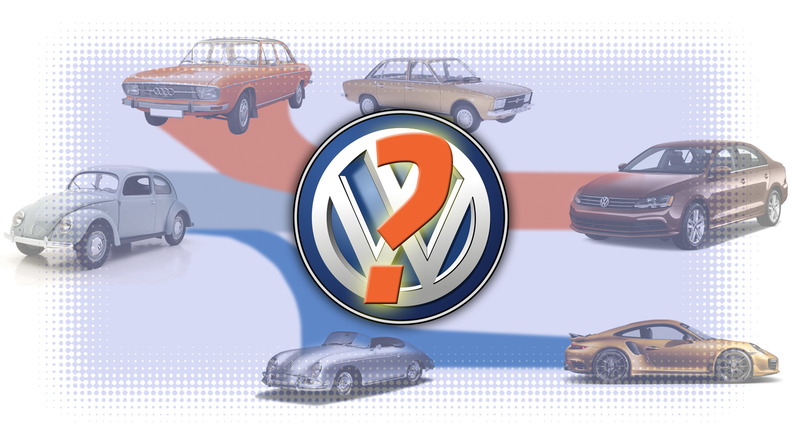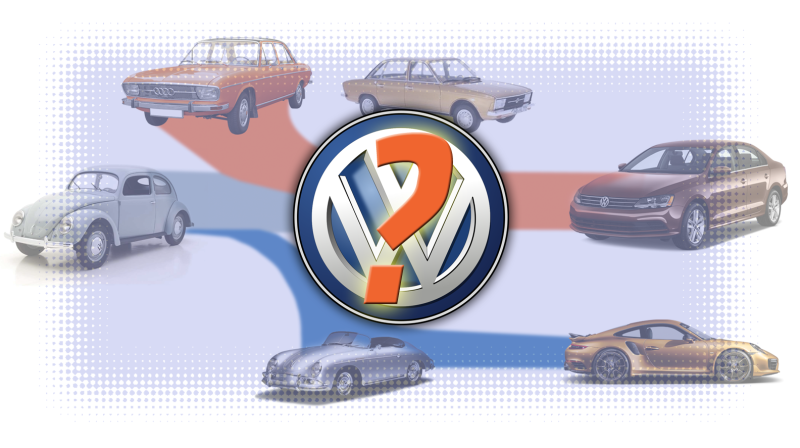
One of the concepts carmaker PR and marketing people have come to really latch onto in recent years is the idea of a carmaker’s “DNA.” By DNA, they mean a fundamental set of ideas, technical concepts, and design that have come to define a given manufacturer. It’s not a bad way to think about things, but it can lead you to some strange conclusions. Like this: there is no Volkswagen. Well, not DNA-wise. The company we call Volkswagen today is really made from Auto-Union DNA. I’ll explain.
Not all carmakers have especially clear roots, but some certainly do, and Volkswagen was one of them. Carmaker DNA can evolve and change, just as biology likes to do so much. A company may start making cars with a certain technical concept, then gradually evolve and change the concept, possibly ending up with something radically different.
Take Renault, for example. Right after WWII they were making cramped, curvy, little 4CVs with a water-cooled inline-four at the rear. They later developed this car into the Dauphine, which had basically the same engine in the same place, but a much more modern body style. Then came the Renault 4, which moved that same engine up front, driving the front wheels, and surrounded it with a spacious, boxy wagon-like body.
The differences between that 4CV and the Renault 4 are pretty dramatic: opposite layout, radically different look and design, but there’s still a clear, unbroken path of development of that Renault DNA. The changes and evolutions came from within, and often repurposed the same crucial parts in new ways.
Advertisement
Other carmakers have specific cars that have clearly and dramatically evolved technically, but still retain the fundamental DNA. Our Jeep-obsessive David Tracy was explaining how radically different the latest Jeep Wrangler is from the original Willys Jeep, being well over twice as big and sharing zero parts, but I maintain the fundamental Jeep DNA is retained.
The basic technical layout and design of the car are the same, the role of the car is largely the same, the overall look and design has been deliberately maintained—yes, it’s completely modernized, but it’s a modernized version of the same fundamental idea.
Advertisement
Now, with Volkswagen, things are quite different. For decades, the company’s DNA didn’t make radical evolutions at all. When the time finally came for a change, internal plans for new developments were passed over in favor of a wholesale injection of all-new DNA from an outside source: Auto-Union.
If we want to get all biological about this, the water-cooled, front-engine, front-wheel-drive Auto-Union designs and DNA were like an invasive species that came into Volkswagen and gradually—but fairly rapidly—took over the overall organism.
Advertisement
In more detail, it went like this: Volkswagen had relied on their basic DNA of rear-mounted, air-cooled horizontally opposed engines since the original KdF Wagen/Beetle from 1938. They developed this into commercial vehicles (Type II), sporty cars (Karmann Ghia), family cars (Type 3 and Type 4) and even niche cars like the VW Thing or the Fridolin.
Sure, developments happened like fuel injection and unibody construction on the Type 4, but fundamentally, it was the same 1938 tech. When they realized—almost too late—that the time had come for a radically more modern design, they put aside the in-house developments of their DNA, the EA266 project, in favor of technology from an outside company, Auto-Union, which Volkswagen had purchased in 1964.
Advertisement
Volkswagen also purchased NSU in 1969, and while their fundamental technology was close to what Auto-Union used (water-cooled, front engine/front drive) the real seed for modern VW came more from the Auto-Union side.
Auto-Union’s DNA is interesting as well, since Auto-Union was really four companies: Wanderer, Horch, DKW, and Audi. Of all of these DKW was the biggest seller, making mass-market front-wheel-drive cars using compact two-stroke engines. Wanderer and Horch were premium brands (VW actually didn’t get the rights to Horch, which is surprisingly still owned by Diamler-Benz) and Audi was sort of a dead marque.
Advertisement
The Auto-Union DNA that VW bought really came from Mercedes-Benz through one engineer’s rather gorgeous prototype, as I’ve written about before. I don’t really consider that true Mercedes-Benz DNA, though, because cars using that DNA were never actually sold as Mercedes-Benzes.
That DNA was used in Auto-Union cars thanks to Mercedes-Benz’ purchase of Auto-Union in 1958. They wanted to move DKW from two strokes to four, and they had the engine design to do so. This became a new DKW, which got a name change to Audi to distance itself from DKW’s smoky two-stroke past. When VW bought Auto-Union in 1964, that Audi eventually developed further and became the basis for the first Passat.
So there you have the DNA for Volkswagen as we know it today tracing its roots back not to some ancestral VW, but to an Auto-Union developed from a Mercedes prototype.
Advertisement
Sure, VW still built their traditional air-cooled, rear-engined designs (and sometimes Franknsteins with air-cooled front engines) for quite a while (remember, Beetles lasted until 2003 in Mexico) but, really, the development thread of that true Volkswagen DNA was dead.
VW DNA did sort of manage to keep alive by spawning the one true Volkswagen DNA offshoot, Porsche, which keeps the remnants of original VW DNA alive to this day, significantly evolved, of course, with its rear- and mid-mounted, boxer-engined cars, the 911, Boxster, and Cayman.
Advertisement
Those cars are more Volkswagen than modern Volkswagen is.
If we’re really going to use DNA as a guide, then that new Jetta you saw on the road is really better thought of as an Auto-Union Jetta. Is life more exciting if you think of every Golf you pass as the latest DKW?
Really, if VW was all about the open disclosure of their DNA, the Volkswagen nameplate would be gone, and Audi would be the primary brand, possibly with DKW as a sub-brand. Modern Audis do have a pretty clear DNA history back into their Auto-Union/DKW roots, after all.
Advertisement
Volkswagen isn’t the only company like this, of course. And, once you start really digging, the whole automotive landscape gets a lot richer and more interesting. Subaru, for example, is said to have studied the Lloyd Arabella flat-four engine extensively when developing their own flat-four.
Those flat-four engines are still the core of Subaru’s DNA today—does that mean a little bit of Lloyd lives on deep inside the crankcase of every Outback?
Advertisement
I’d like to think so.













